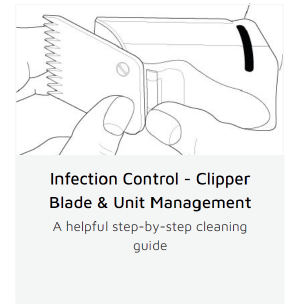Clippers are one of the most used and abused pieces of equipment in a veterinary practice. Almost every staff member will pick up and use a pair of clippers for a whole host of reasons at some point during the working day, from clipping for an IV, removing the hair around an abscess or wound, to preparing for surgery.
Have you ever asked yourself the following?
- How often are the clippers cleaned and maintained?
- How often are the blades cleaned or changed?
- Is there a designated pair of clippers for each area of the practice?
- Are we using blunt blades on a patient?
- Are the clippers being handled, used and stored correctly?
- Is there a protocol in place within the practice for all the above?
As the infection control advisor for Pioneer, and having worked in referral for 11 years, I have a keen interest in maintaining high levels of hygiene and cleanliness throughout the practice. I can almost guarantee, in most practices, the clippers are overlooked on numerous occasions every day.
What should we be doing?
Let’s start by thinking about what areas we use clippers. We will usually find clippers throughout the practice, in consult rooms, kennels and cattery, prep area, dental, Xray and isolation. Understandably not all clinics will have each of these designated areas, and there will be some cross over in the use of rooms, but should there be a cross over with the use of clippers? Would you consider this the best way to implement infection control procedures in practice?
Currently, are you having to use the same clippers in consult rooms and the prep area? Is the same pair of clippers used to clip a dirty wound as well as a surgical wound? If so, I would highly recommend purchasing new clippers, one for each defined area of the practice. The reasoning behind this was highlighted very recently where an IV was clipped on a patient with a dirty pair of clippers, sepsis followed, and the patient, unfortunately, had to have its limb amputated! This might be quite an extreme case, but it does highlight how poor protocols can inflict unnecessary suffering on our patients and distress to owners.
This then brings me onto clipper blades. Whilst working in referral, the practice protocol was to use one set of clipper blades per patient. Whether in consults, prep, kennels etc. After use, the blades would be removed, cleaned, and then resterilised via Ethelene Oxide sterilisation. I do appreciate gas sterilisation is not widely used in practice, however, there is the option of using cold sterilisation or even just ensuring the blades are cleaned thoroughly after each use, and contact times for disinfectants are adhered to. After moving from referral back to first opinion, I was able to implement these changes successfully.

I have produced a Clipper Cleaning and Maintenance SOP, which is available for free via the resources page when you sign into your myPlus account on the website. The SOP has been designed to be placed in prominent areas within the practice and adapted to run in line with the practices’ own protocols.
If you would like to discuss clipper management, use and maintenance, or any other areas of infection control, including SOP’s, please do contact me.








